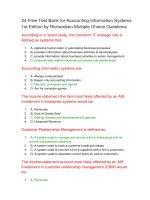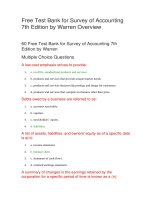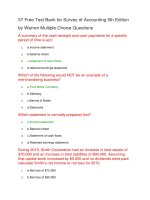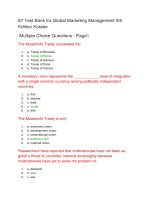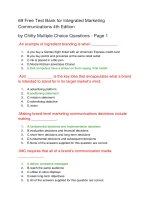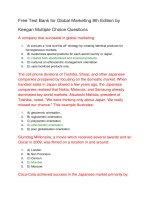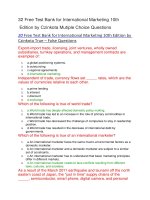80 free test bank for modern marketing research 2nd edition
Bạn đang xem bản rút gọn của tài liệu. Xem và tải ngay bản đầy đủ của tài liệu tại đây (112.33 KB, 18 trang )
40 Free Test Bank for Modern Marketing Research
2nd Edition by Feinberg Mutiple Choice Questions
25 Free Test Bank for Modern Marketing Research 2nd
Edition by Feinberg True – False Questions
10 Free Test Bank for Modern Marketing Research 2nd
Edition by Feinberg Free Text Questions
------------40 Free Test Bank for Modern Marketing Research
2nd Edition by Feinberg Mutiple Choice Questions
Conclusive research is meant to provide information to help the decisionmaker
1.
a.evaluate and select a specific course of action from among the options
previously identified
2.
b.select the correct sampling procedure
3.
c.identify the information needs based on the research objectives
4.
d.clarify the problem or opportunity being faced
If a product’s share of the market is below the forecasted share, then this
would be an example of a(n)
1.
a.problem
2.
b.opportunity
3.
c.symptom
4.
d.both a and b
The process of marketing research involves five steps designed to aid
managerial decision-making. After determining what information is
needed, the next step would be to
1.
a.manage the data collection
2.
b.design a method for collecting information
3.
c.communicate the findings
4.
d.analyze and interpret the results
During which step in the research process would a large proportion of the
research budget be spent and a sizeable proportion of the “total error” be
incurred?
1.
a.designing the data collection procedure
2.
b.collecting data
3.
c.processing and coding data
4.
d.analyzing data
Situations where performance can be improved by a change in activities
are
1.
a.symptoms
2.
b.performance measures
3.
c.opportunities
4.
d.information needs
Often decision-makers can identify gaps in the original list of research
needs by
1.
a.visualizing the research findings
2.
b.developing concrete objectives
3.
c.selecting the correct sample
4.
d.specifying the information needs
When visualizing the research findings, the data chosen for presentation
in the mock-up should represent all of the following possible results
except
1.
a.optimistic
2.
b.pessimistic
3.
c.collected data
4.
d.most likely
Dependent variables are
1.
a.predictors of a phenomenon
2.
b.covariates or causes of a phenomenon
3.
c.used to explain independent variables
4.
d.phenomena one seeks to explain
An example of a problem would be
1.
a.market share has declined by 3 percent since last year
2.
b.brand awareness has declined by 5 percent
3.
c.the advertising campaigns used over the last year have been less effective
4.
d.all of the above
A centralized marketing research department offers all of the following
advantages except
1.
a.researchers are “are close to the action” of marketing problems and
implementation of their recommendations
2.
b.more economical and flexible use of facilities and personnel
3.
c.greater institutional prestige and credibility to marketing research
4.
d.greater likelihood of attracting top-notch researchers and securing an adequate
budget
Mocked-up data used to visualize the results of a study will tend to lack
uncooperative features present in real-world data such as all of the
following except
1.
a.missing fields
2.
b.insufficient sample size
3.
c.miscodes
4.
d.self-selection bias
Typical motives for “pseudo-research” include all of the following except
1.
2.
a.using marketing research as a way to gain visibility and power in the
organization
b.informing a decision among several possible courses of action
3.
c.establishing a scapegoat for marketing decisions that do not accomplish
objectives
4.
d.promoting service organizations such as advertising agencies and media to
attract new business and impress current clients
Contribution margin is
1.
a.selling price minus variable costs
2.
b.selling price minus fixed costs
3.
c.selling price minus variable and fixed costs
4.
d.profit per unit divided by variable costs
An example of a situational analysis would be an analysis of
1.
a.desired product features
2.
b.demand
3.
c.the firm’s advertising program
4.
d.the best price
Decision criteria are rules for
1.
a.choosing objectives, given various information needs
2.
b.choosing sampling procedures, given the size of the sample
3.
4.
c.choosing the appropriate quantitative analysis, given the form of the collected
data
d.selecting among courses of action, given various data outcomes
Challenges in conducting effective marketing research internationally
include all of the following except
1.
a.markets in less developed countries are less likely to have good secondary data
2.
b.in some countries cultural dynamics or concerns about government surveillance
may negatively impact results
3.
c.marketing research techniques used in the United States are not applicable in
other countries
4.
d.logistical dimensions of implementing marketing research are complex and,
therefore, tend to cost more
The sum of all errors that may occur in the research process over and
above the sampling error is called
1.
a.measurement error
2.
b.population error
3.
c.non-sampling error
4.
d.systematic bias
It is easier to justify the cost of research as the market size
_______________ and as the ratio of variable costs to selling price
_______________.
1.
a.increases, increases
2.
b.increases, decreases
3.
c.decreases, increases
4.
d.decreases, decreases
In selecting a sample for a telephone company, a researcher used the
local telephone book. Given that individuals with an unlisted number,
individuals with cell phones, and individuals without any type of phone
would not be included, this illustrates which type of non-sampling error?
1.
a.incorrect population definition
2.
b.sampling frame non-representative of the population
3.
c.non-response errors
4.
d.faulty problem definition
Increasing market share by 3 percent by next year would be an example of
a(n)
1.
a.symptom
2.
b.problem
3.
c.opportunity
4.
d.decision objective
All of the following are characteristics of industrial marketing research
except
1.
a.difficult to find good executive interviewers
2.
b.respondent definitions are usually fairly simple
3.
c.study costs per interview are higher than for consumer research
4.
d.respondent cooperation is a major concern
The difference between a sample value and the true underlying population
value is called
1.
a.sampling error
2.
b.non-response error
3.
c.measurement error
4.
d.systematic error
Conflicts between researchers and management is not uncommon.
Common attitudes among marketing researchers regarding top
management include all of the following except
1.
a.required research is generally too costly
2.
b.top management is anti-intellectual
3.
c.there are too many non-researchable, “fire-fighting,” and proof-of-concept
requests
4.
d.top management is generally unsympathetic to the importance of problem
definition, often re-defining the problem after the research is under way
_______________ answers the questions, “What specific information is
required to attain the objectives?”
1.
a.Symptoms
2.
b.Research design
3.
c.Information needs
4.
d.Data sources
The growth of marketing research activity dramatically increased after
World War II because of
1.
a.increased computer technology
2.
b.mass production of goods
3.
c.the development of television
4.
d.the acceptance of the marketing concept
The first step in the marketing research decision-making process is
1.
a.developing a hypothesis
2.
b.collecting relevant data
3.
c.outlining a process that can be used to collect the necessary information
4.
d.recognizing a unique marketing problem or opportunity
The main criteria for marketing research includes all of the following
except
1.
a.systematic
2.
b.objective
3.
c.related to the 4 P’s
4.
d.targeted for decision-making
The value or benefit of formal marketing research is typically
commensurate with
1.
a.the cost of conducting the research
2.
b.the amount of time it takes
3.
c.the clarity of the decision to be made
4.
d.the ability of the research to reduce uncertainty in the decision-making process
_______________ research is often needed to facilitate the development of
the statement of problems and opportunities.
1.
a.Conclusive
2.
b.Exploratory
3.
c.Pseudo-
4.
d.Causal
If syndicated research companies collect data through large-scale
consumer panels and track what its participants do, buy, and think, then
marketing research is playing a role in
1.
a.marketing
2.
b.the firm
3.
c.the marketing research industry
4.
d.in society
In designing the sample, researchers need to clearly define all of the
following except
1.
a.the questions to be asked
2.
b.the population from which the sample is to be drawn
3.
c.method used to select the sample
4.
d.the sample size
An example of an opportunity would be
1.
a.an ad campaign was not as effective as forecasted
2.
b.a hotel experiences a decline in revenues
3.
c.a competitor has more effective advertising
4.
d.consumer preferences for snack foods shifted to products free of wheat gluten
Variables directly under the control of management that lead the
organization’s performance to fall short of objectives are
1.
a.symptoms
2.
b.problems
3.
c.opportunities
4.
d.information needs
The formal beginning of marketing research was
1.
a.in 1900
2.
b.between 1910-1920
3.
c.between 1925-1940
4.
d.in the 1950s
Elements of the marketing mix, such as pricing and ad spending, are
viewed as decision variables that the firm can use to steer the market.
Therefore, in developing a model these decision variables would be
considered
1.
a.independent variables
2.
b.dependent variables
3.
c.connecting variables
4.
d.statistical variables
All of the following are types of non-sampling errors except
1.
a.faulty problem definition
2.
b.incorrect population definition
3.
c.sampling frame is not representative of the population
4.
d.small sample size
The objective “to study consumer reactions to cartoon characters in
advertising” is insufficient for all of the following reasons except
1.
a.it does not indicate what type of market will be studied
2.
b.it does not indicate what is to be measured
3.
c.it does not indicate the cost of the study
4.
d.it does not indicate how the information will be used
In the marketing management process, essential sets of information
required for planning include all of the following except
1.
a.marketing mix variables
2.
b.situational variables
3.
c.marketing mix variables
4.
d.performance variables
Syndicated data sources
1.
a.solve client-specific problems
2.
b.collect data and then sell these data on a subscription basis
3.
c.provide specific services, such as field interviewing or data analysis
4.
d.undertake complete research studies for client organizations
Obstacles (or barriers) to the effective use of marketing research by
management include all of the following except
1.
a.viewing research as a threat to their personal status as decision makers
2.
b.inability to work with researchers or use their knowledge and skills
3.
c.insistence on considering experience and personal judgment in decision process
4.
d.differences in emphasis and temperament
25 Free Test Bank for Modern Marketing Research
2nd Edition by Feinberg True - False Questions
Research objectives answer the question, “Why is the project being
conducted?”
1.
True
2.
False
Exploratory research can be helpful in identifying innovative courses of
action.
1.
True
2.
False
In practice, decision-making rarely relies wholly on an input-output
framework of marketing research and formal statistical models, but
combines them with managers’ experience, judgment, and intuition.
1.
True
2.
False
It is rather easy to calculate the benefits of a research project, but
calculating costs is much more difficult.
1.
True
2.
False
Because of their role in collecting, analyzing, and reporting data,
marketing researchers are often asked to make managerial decisions.
1.
True
2.
False
The criteria that research be systematic means that researchers strive to
be unbiased and impartial in conducting their research.
1.
True
2.
False
Exploratory research can be used as an aid in defining the decision a
manager must make and developing hypotheses.
1.
True
2.
False
The decision-maker, who has a clear perspective on the specific
information needed to reduce the uncertainty surrounding the decision
situation, should be actively involved in formulating the information needs
for a research project.
1.
True
2.
False
Despite major differences in consumer and industrial marketing research,
the underlying methods and skills are nearly identical.
1.
True
2.
False
Dependent variables are inputs or causes used to explain a particular
phenomenon.
1.
True
2.
False
Non-sampling errors tend to decrease as the sample size increases while
sampling errors tend to increase as the sample size increases.
1.
True
2.
False
During the 1930s, sampling became a serious methodological issue in
marketing research.
1.
True
2.
False
Not only are research objectives rarely relayed to the marketing
researcher at the outset of a research project, but decision-makers
seldom formulate objectives accurately.
1.
True
2.
False
A systematic approach to researching the information needs of marketing
management facilitates good organizational planning in developing
objectives, allocating marketing resources, and auditing performance.
1.
True
2.
False
Researchers must develop a data-collection procedure that establishes an
effective link between the information needs and the questions to be
asked or the observations to be made.
1.
True
2.
False
The purpose of marketing research is to gather information that will
improve managerial decisions.
1.
True
2.
False
In identifying alternative courses of action, “doing nothing” or “status
quo” is not a feasible alternative.
1.
True
2.
False
The main disadvantage of the integrated structure of a marketing research
department is the isolation of researchers from day-to-day activities and
problems and the difficulty of finding qualified people.
1.
True
2.
False
The process of identifying problems and opportunities involves analyzing
future situations that a firm will face; the past is a sunk cost because it
can no longer be changed.
1.
True
2.
False
One of the steps in the research process is to process and code data.
Coding involves reviewing the data forms as to legibility, consistency, and
completeness.
1.
True
2.
False
As a general rule, frequently purchased consumer goods can support
more expensive marketing research than can high-cost durable goods.
1.
True
2.
False
Problems are performance measures, metrics, and diagnostics that signal
the presence of an opportunity.
1.
True
2.
False
Research suppliers can be used to conduct components of a research
study, but they are never given total responsibility for a research study in
its entirety.
1.
True
2.
False
Good horizontal relationships (teaming of researchers with product
managers) are more important than vertical ones (e.g., reporting to the
senior marketing executive).
1.
True
2.
False
Decisions must aim at solving problems or taking advantage of
opportunities, not at treating symptoms.
1.
True
2.
False
10 Free Test Bank for Modern Marketing Research
2nd Edition by Feinberg Free Text Questions
Discuss the concepts of symptoms, problems, and opportunities. Give an
example of each.
Answer Given
Symptoms are performance measures, metrics, and diagnostics that signal the
presence of a problem or opportunity. In marketing research, the word “problem”
refers to those variables—particularly variables under direct managerial control—
that lead the organization’s performance measures to fall short of objectives. An
opportunity refers to a situation where performance can be improved by a change
in activities. Student examples will vary greatly. Examples of symptoms should
refer to a metric (such as declining sales) divorced from its underlying cause.
Examples of problems should refer to something that leads to an under
performance (such as an ineffective advertising strategy). Examples of
opportunities should refer to an instance where a change in a condition opens a
new possibility for improved performance (such as adding a new line of product
when consumer tastes shift).
The field of marketing research amounts to a set of methodologies
designed to aid managerial decision-making. What are the essential steps
in this approach?
Answer Given
The essential steps are: 1. Determine what information is needed; 2. Design a
method for collecting this information; 3. Manage the data collection; 4. Analyze
and interpret the results; 5. Communicate the findings in a way that clarifies the
implications for decision-making.
The general approach and techniques of marketing research applies to
both domestic and international contexts, but additional issues that must
be considered in international research. Discuss these issues that are
unique to the international arena.
Answer Given
The level of uncertainty pervading the entire enterprise will be greater in the
international than in the domestic context. The cost of doing marketing research is
often much higher outside areas in which there is a highly developed research
infrastructure. Markets in developing areas are often not as large, so potential
revenue an profits are more modest. A great deal of attention must be paid to
translation of language and sensitivity to cultural differences to avoid big
marketing blunders.
Explain the difference between independent and dependent variables.
Answer Given
Dependent variables are phenomena a researcher seeks to explain, whereas
independent variables are used to explain them.
What is meant by the term “market”?
Answer Given
Generically, the market is everyone who could possibly participate in buying,
leasing, subscribing, or trading for a specific product or service and everything that
could plausibly be involved in these activities.
List the topics that should be considered in a research proposal.
Answer Given
Topics to include are: 1. problem; 2. objectives; 3. alternatives; 4. informational
needs; 5. personnel qualifications; 6. evaluation; 7. budget; 8. timetable.
What is the contribution margin if the selling price is $25.00, variable
costs are $13.00, and fixed costs are $50,000.
Answer Given
$12.00 (25–13)
Compare and contrast consumer versus industrial marketing research.
Answer Given
Consumer marketing research involves a large population, respondent
accessibility is fairly easy, respondent cooperation has become increasingly more
difficult to obtain, sample size can usually be drawn as large as is needed,
respondent definitions are usually fairly simple, interviewers can be readily trained,
and the key dictators of study costs are sample size and incidence. In comparison,
industrial marketing research involves a small population, respondent accessibility
is difficult, respondent cooperation is a major concern, sample size is usually
much smaller than for a consumer sample, respondent definitions are more
difficult, interviewers are more difficult to train, and study costs per interview are
usually considerably higher than for consumer research.
Discuss the nature and various types of non-sampling error.
Answer Given
Non-sampling error refers to all errors that may occur in the research process over
and above the sampling error, including those arising from both inadvertent
mistakes and deliberate deceptions. Specific types of non-sampling error include
faulty problem definition, incorrect population definition, sampling frame nonrepresentative of the population, non-response errors, poor questionnaire design,
measurement error, and improper causal inferences.
A research project costs $80,000. Selling price is $30.00 and variable
costs are $20.00. What is the break even point to cover the costs of the
research?
Answer Given
8,000 units ((80,000/(30–20))
